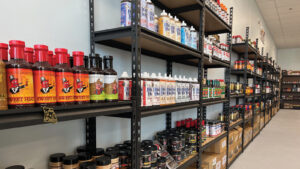Even before the Columbia Mall’s Oct. 9, 1985, grand opening, downtown retailers had a battle plan.
The mall’s 708,190 square feet of retail space, including anchors Dillard’s and Sears and 50 other retail shops, dwarfed the 400,000 square feet of downtown that sold comparison goods. By August 1985, days after Sears opened but months before the rest of the mall followed suit, the Central Columbia Association and the Special Business District agreed to more than double their 1986 advertising budget from $32,000 to $72,000.
“We will market downtown as a unique and distinctive place to shop. We offer more than any great mall can.”
That’s what Ed Gaebler, the executive director of the Central Columbia Association, told the Columbia Daily Tribune in June 1985.
Despite the advertising offensive, Columbia consumers didn’t buy it. Around 150,000 shoppers flocked to the mall in its five-day grand-opening period, with about 50,000 coming on opening day.
Starting not long after the mall was first proposed, downtown merchants successfully pushed for the creation of a new parking tower at the intersection of Eight Street and Walnut to lure shoppers downtown and away from the mall. The garage was approved, but only around 100 of the 400 spaces in the $2.5 million project were ready for use in time for the Christmas shopping season.
Roth’s Department Store in the Forum Shopping Center was the first mall casualty. It announced its closing plans in December 1985, citing declining sales exacerbated by the mall’s competition.
Changing landscape
The Biscayne Mall, which opened in 1972, and Parkade Plaza, which opened in 1965, also faltered in the mall’s wake. Neither had advertising budgets to compete with the mall, and both saw tenants pack up and move.
Parkade Plaza in particular was hit hard. Before the mall opened, three of its tenants signed leases with the mall and a fourth closed, citing the uncertain future of the plaza. The plaza eventually lost J.C. Penney, a 20-year tenant and its largest business, to the mall in the summer of 1987. J.C. Penney became the mall’s final anchor after Target joined in summer 1986.
By fall 1987, the plaza was up for sale with fewer than 10 of its 25 store spaces leased. With a $6 million asking price, the space had no takers. Its owners transformed the plaza to a mixed-use development, drawing government institutions and other employers with promises of office space. Now called the Parkade Center, the plaza has changed ownership several times since 1987 but still houses a mix of offices and retail shops and is currently owned by the Burnam family.
For the city, the mall was more than just a new place to shop. City planners had to prepare previously seldom-traveled roads for high levels of traffic congestion, and the Columbia Planning and Zoning Commission revised an old sign ordinance banning animation to give the mall its flashing, neon front sign.
Initially, it looked like the mall could have some benefits for downtown businesses. Residents in Boone County and other nearby counties said they viewed all of Columbia, not just the mall, as a place to shop. A poll the Columbia Missourian and KOMU-TV conducted after the mall opened suggested 80 percent of Boone County residents had seen the new mall, as had sizeable percentages of residents in nearby counties.
Holding out hope
Retailers downtown were quick to call their sales declines only temporary. Some said their sales slump spanned only the mall’s first two weeks of operation.
But by 1987, it was clear the situation wasn’t short lived. When three stores shuttered in a two-week period in October 1987, two of the three cited the mall as the reason for their exit. Some merchants hoping to sell their stores instead of close them completely had problems finding buyers, most of whom were wary of mall competition.
Eighty-one downtown businesses closed between late 1986 and late 1987. Although new businesses replaced many old ones, vacancies crept higher. Offices also began to replace some former retail space, a development that some considered less than ideal.
To combat their woes, downtown retailers considered adding free parking and evening hours to boost business. In December 1987, the Special Business District hired a development expert to help capture more shoppers. The expert, who also managed malls, advocated for creating a more unified management among downtown businesses. Instead of handling their individual leases and sales, the expert advocated that the business owners collaborate to present a united front, almost as if they leased from a mall company and answered to mall managers.
Although other Columbia businesses suffered, the new mall was a success. About a year after opening, the mall’s sales ranked fourth among its parent company’s similarly sized malls. Its anchors remain unchanged after nearly three decades.
In the present
The mall underwent a renovation in 2004 and has room for 140 retail stores. Its four-screen movie theater was replaced with a Barnes & Noble. An H&M is set to open in fall 2014, and a sit-down restaurant, Toby Keith’s I Love This Bar and Grill, is also slated to open soon.
Mall General Manager Rusty Strodtman says mall sales have remained strong throughout the years, and the mall holds its own among his company’s other malls in mid-sized markets.
“We fall on a very similar trend to Columbia in that we don’t have a lot of ups and downs,” Strodtman says.
The mall hit its highest sales volume per foot in 2011 and also did well in 2012 and 2013. By the end of 2014, Strodtman says he expects mall occupancy to be between 97 and 98 percent.
“That’s not unheard of, but it’s much higher than the national average,” Strodtman says. “We as a company are very happy with Columbia.”
About a dozen of the mall’s stores are original to the 1985 opening, but most storefronts have changed three or four times, Strodtman says.
Downtown managed to recover after its onslaught of store closings. Its vacancy rate was 3 percent in 2013. Office space replaced some vacant storefronts, and as of 2013, offices still made up more than half of The District’s retail balance. Twenty-six percent of the balance is retail stores, and 18 percent is restaurants.
The District has no trouble attracting gourmet restaurants and independent retailers, says Carrie Gartner, executive director of the Downtown Community Improvement District. In its retail stores, The District’s niche is often smaller businesses that may still carry well-known brands.
Gartner says that today, The District is more than a place to shop.
“It’s clearly about a different type of experience, not necessarily just running errands,” Gartner says, pointing out that The District also boasts space for production facilities such as studios and breweries. “It’s really changing what people think of when they think of shopping. It’s a much richer experience.”









